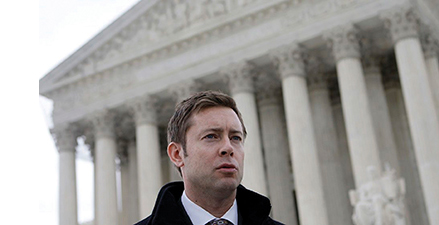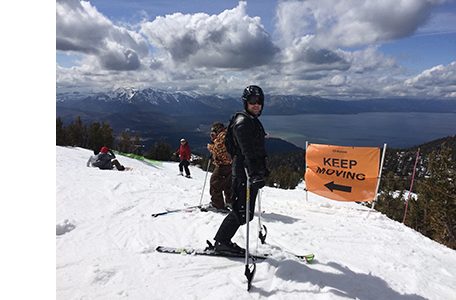Whether he’s fighting for amputees’ rights or skiing a slalom course, Doyle charges hard out of the gate and stays on the attack.
By Larry Borowsky
It was a routine denial of coverage, the sort of experience people with limb loss go through umpteen times a day. David Trujillo, a 27-year-old above-knee amputee, had filed a claim for a HiFi Interface Socket prosthesis, which his prosthetist recommended as necessary to support Trujillo’s active lifestyle. His insurer, United Healthcare, had rejected the claim because his insurance plan only covered “the most basic device that meets your needs.” Trujillo appealed; United stood firm. He requested a reconsideration of the appeal. Sorry, United responded; you’re just not covered. The policy language couldn’t be clearer.

“Insurance companies and their lawyers are not all evil people,” says Trujillo’s attorney, Conal Doyle. “It may not seem like it when they deny a prosthetic limb to an amputee. But sometimes they’re human.”
It’s unclear whether insurers and their legal departments would give Doyle the same benefit of the doubt. His successful class-action lawsuit on behalf of Trujillo and co-plaintiff Deanna Harden (the parent of an upper-limb amputee) forced United Healthcare to change unlawful claims practices and reprocess previously denied claims. A separate class-action suit against Anthem culminated in a preliminary settlement last year, forcing more policy changes. Doyle has at least two similar cases pending. And he routinely offers pro bono legal advice to amputees, helping them hold insurers, manufacturers, and other institutions accountable without a trip to the courtroom.
Even if you’ve never heard of Doyle, you may have benefited from his advocacy. His legal victories have compelled major insurers to rewrite their policies, revise their evaluation practices, and beef up their medical review teams. “When you get a payer as big as Anthem to change their policy [regarding prosthetics] from what is essentially a noncovered benefit to a covered benefit, it’s a big breakthrough,” says Dave McGill, president of the American Orthotic and Prosthetic Association. “It offers far more people with limb difference the opportunity to use these devices.”
As a congenital above-knee amputee, Doyle brings plenty of personal conviction to his cases. But his success has been fueled more by clear-eyed analysis than fiery passion. His starting point is the knowledge that, when it comes to prosthetics, insurers’ decisions often rest on a ridiculously weak foundation. Their policies are littered with clauses that reflect a woefully outdated grasp of limb loss and prosthetics, based on science that may be ten or 20 years behind the times.
“United Healthcare is the largest health insurer in the country,” says Doyle. “But I found out that they did not have a single prosthetist they consulted with or employed. The person who wrote their education modules and trained their doctors to adjudicate claims was a high-school dropout who had no training or expertise in prosthetics whatsoever. He took a course and earned some sort of certification, which is meaningless.”
These things would be funny if they weren’t so infuriating. But fury doesn’t win insurance disputes. Evidence and strategy do. And even though insurers’ bureaucratic bulk gives them a built-in advantage, consumers can prevail by patiently, persistently exploiting an edge they may not realize they have—their superior understanding of what’s necessary, and what’s possible, in achieving healthy adaptations to limb loss.
Doyle thinks this leverage can yield victories in disputes of any scale, from individual claims to class-action litigation to legislative debates over what constitutes fair, patient-centered coverage. “It’s very important to present the right case and do it in the right way,” he says. “You’ve got to start with the basics, look into the plain language of the policy, and build up from there.”
PLAYING TO WIN
Growing up, Doyle didn’t envision himself as a future courtroom crusader. “My first passion was sports,” he says. “I was very athletic, and I played a lot of different sports.” He had a particular aptitude for skiing, which you might not expect for a kid from Syracuse, New York. But a neighbor had a family connection to the manager of Toggenburg Mountain, so Doyle learned to carve turns on one leg and started racing. He competed against able-bodied skiers throughout his teen years, and when he graduated from college in 1993, he wasn’t sure whether to enroll in law school or head to the Rockies and become a ski bum.
“I was very close to doing that,” he laughs. “It was very attractive.” But a good score on the LSAT and some work experience in a law office changed his mind. “I thought I might be good at [law],” Doyle says, “and I liked the idea of helping people who’ve had an amputation or a spinal cord injury get back to becoming active. I understood that client population pretty well, so I felt I could add some value and be empathetic.”

“2020 Streetfighter of the Year”
by the Consumer Attorneys of
California. Image courtesy Doyle Law.
Doyle took a detour to the defense table straight out of law school (Florida State University, 1997) on the advice of two mentors. “They told me to learn how insurance companies evaluate cases and how they defend them, because that knowledge will be invaluable when you come over to the plaintiff’s side,” he recalls. So he spent six years representing doctors, hospitals, corporate employers, and other high-and-mighty clients, until he felt well equipped to do to battle against those same parties. “I had learned what I needed to know,” he says, “and it was time to help real people and make an impact on their lives.”
Doyle relocated from Florida to California in 2003 to establish his own practice. First, though, he had to work the last vestiges of snowsports daredeviltry out of his system. The 2006 Winter Paralympics beckoned, and there was still time to qualify for a spot on Team USA. He started racing on the adaptive circuit and became friendly with a number of world-class paraskiers. “There was a guy named Monte Meier, who was probably the best three-tracker in the world at that time,” Doyle says. “But he trained year-round. I was already a trial lawyer, and I was serious about my legal career. I thought, ‘I can’t compete with these guys.’”
You can still see traces of the downhill racer in Doyle’s judicial demeanor, however. When he takes on a case, he sizes up the obstacles on the course and picks out a line. Once the starting bell sounds, he charges hard out of the gate and attacks, helmet over his skis. He plays fair and by the rules, but he’s not simply doing it for the thrills and the camaraderie. He’s out there to beat you.
PLAIN LANGUAGE
By the time David Trujillo and Deanna Harden’s complaints against United Healthcare came to Doyle’s attention in 2017, he already had national stature and a strong track record against heavyweight opponents. One of his first big wins, a medical malpractice suit on behalf of a leg amputee, culminated in a multimillion-dollar settlement after two years of bruising litigation. That case brought Doyle to the attention of a nonprofit that was seeking representation for an undocumented immigrant named Francisco Castañeda, who’d been denied a biopsy for a cancerous growth while in government custody and wound up with a terminal prognosis.
He died two years later, but Doyle kept fighting on behalf of Castañeda’s widow and daughter. The complex case went all the way to the US Supreme Court, drawing the attention of 60 Minutes along the way. In the end, Doyle secured a $1.95 million pretrial settlement from the federal government and a $1.73 million judgment (later revised to $1.25 million) against the State of California. Those outcomes ultimately led to sweeping healthcare reform within the U.S. immigration system.
Doyle made headlines again in 2015, securing a $13.3 million settlement on behalf of a quadrilateral amputee whose limb loss was caused by negligent care of an abdominal infection. It was one of the largest medical malpractice recoveries ever in California, a state with medical malpractice caps, and Doyle secured it in no small part through his detailed understanding of prosthetic technologies and costs.
That same expertise proved decisive in the litigation against United Healthcare, which transpired between 2017 and 2019. As he sized up the case, Doyle spotted an unusual detail: The insurer’s restrictive coverage of prosthetic devices was explicitly embedded in its coverage documentation, under Guideline CDG.018.06 (“Prosthetic Devices, Wigs, Specialized, Microprocessor or Myoelectric Limbs”).

Paralympics. Image courtesy Conal Doyle.
“A lot of times they don’t put it in the actual policy language,” he says. “With United Healthcare, their Evidence of Coverage said that if more than one prosthetic device can meet your functional needs, you get the device that meets the minimum specifications for those needs. That’s a mouthful of insurance company BS, but it basically says you get the cheapest leg; you get the cheapest arm. That’s what we’re gonna pay for.”
At least, that’s how United was applying the policy. But Doyle argued that what the language actually obligated the insurer to do was evaluate every claim on an individual basis, determine each patient’s functional needs, and then specify which prosthesis actually would meet those needs—with evidence to back up their judgment.
“I know how these insurance companies work, and there’s no way United was doing this analysis,” Doyle says. “Their medical directors are MDs, not prosthetists, and they generally don’t know anything about prosthetics. Even the ones who claim to be experts are not. They just don’t know the technology in detail. There’s no way they were looking at an individual claim and figuring out, ‘We’re going to deny the C-Leg, but we think this hydraulic unit is the one that meets the claimant’s needs instead, and here’s why.’”
But Doyle wasn’t finished picking apart United’s claims practices. Another flaw he unearthed in the language was that it treated a prosthetic device as an integral unit, rather than an amalgamation of components that prosthetists mix and match to suit each client’s lifestyle. This faulty misunderstanding meant that if United deemed any single component of a given claim—the socket, the knee, the ankle, the foot—to be outside the coverage parameters, it simply denied the whole thing.
“If there are parts of the claim that are covered, they’ve got to tell the patient,” Doyle says. “They’ve got to say, ‘The socket, foot, and ankle are covered, but we’re not going to pay for the microprocessor knee. We’ll pay for a hydraulic knee, and if you want to upgrade to a better knee, we’ll cover the amount of a hydraulic unit and you can make up the difference.’”
These lines of attack might have been obvious to anyone (like Doyle) who’s worn an above-knee prosthesis his entire life, but they didn’t impress the able-bodied lawyers defending the case for United. The company filed multiple motions to dismiss the suit, arguing that they had simply applied their written guidelines to the letter. When those actions failed, United showed no interest in reaching a settlement during pretrial litigation, confident it would prevail in court. Less than a week before the trial was set to begin, the judge called both parties together and said there was something he’d never understood about the case. Doyle squirmed; that didn’t sound promising. Then the judge turned to United’s lawyers and said, Here’s what I don’t understand: Why haven’t you settled this yet?
Within a couple of days, United was at the negotiating table.
ONE LIMB AT A TIME
The case against Anthem was built on a different kind of insurer ignorance. In that instance, the company’s documentation essentially defined microprocessor ankles and knees as value-add devices designed for non-essential activities. In truth, Doyle wrote in his initial filing, “a microprocessor controlled prosthesis creates better stability and, therefore, reduces the incidence of stumbles and falls, lessens the extra energy it takes to move an artificial leg, decreases pain and discomfort, and aids walking . . . in every setting.”
It gets worse. The company’s policy regarding microprocessor knees reflected the state of the art circa 1999, when the technology was first introduced in the US. And it still defined microprocessor-controlled foot-ankles, which had been around for more than a decade, as “investigational” devices, and therefore not covered for all indications.
Again, it would be funny if claims hadn’t been denied on that basis for years. The final settlement, which Anthem approved last October, will make it far easier for future claimants to win approval: The company rewrote its policies governing microprocessor knees and ankles and removed the “investigational” designation for foot/ankle devices. That reform is taking place industrywide, says AOPA president McGill, as other insurers weed out similarly written guidelines that won’t stand up in court.
“Anthem was definitely one of the biggest insurers advancing the theory that this was experimental and investigational,” McGill says. “Getting that reversed and having a clear statement that this is a covered item subject to medical- necessity criteria—that’s a far less restrictive approach. It’s very significant.”
While it can be satisfying to score an outright legal win over an insurer, it’s not the most efficient way to create systemic change. Actionable cases aren’t all that common, and truly winnable ones—in which the financial return would be large enough to justify the expense of pressing the suit—are rarer still. And even when a legal defeat forces insurers to liberalize their policies, the industry tends to find another way to clamp back down. Doyle acknowledges that United is still denying valid claims, despite the Trujillo settlement; they’re just doing it on a slightly different basis, using different language that’s harder to attack in a courtroom.
Ultimately, the best way to achieve lasting reform is to write better laws and regulations related to prosthetic coverage. State-level fair-insurance laws supported by the Amputee Coalition are a good place to start, Doyle says. He also favors requiring insurers to issue pre-approval determinations so prosthetists can recommend more advanced devices with greater confidence.
“Let’s say I want a myoelectric arm and hand,” Doyle explains. “If no pre-certification is required for this device, your prosthetist has to lay out at least $40,000 or $50,000 wholesale for the components, make the device, fit the socket, deliver it, and then find out how much they’re going to get paid. The insurer might come back and say, ‘Here’s $15,000. That’s what we’re covering.’ It’s a huge chilling effect that makes it difficult for prosthetists to recommend the devices their patients need.”
This effect is a by-product of Medicare’s byzantine billing codes and reimbursement rates, which don’t always reflect the cost of new prosthetic technologies. Many insurers exploit this system to impose lower reimbursement rates on high-end devices, leaving patients and prosthetists to either settle for a less expensive solution or risk getting stuck with a large, uncompensated bill.
Whether or not you’re inclined to call a lawyer or lobby your congressperson for better laws, says Doyle, amputees can and should act as their own advocates. “If you don’t know what your insurance plan says—the actual plan documents, called the Evidence of Coverage—get that information and analyze it,” he advises. “Read them with your prosthetist and understand the magic words that are going to trigger a denial before you file your claim. Trust me, they want to deny these claims. They’re looking for reasons to deny them. So you’ve got to take a real practical, results-oriented approach and try to figure out the best way to get a good outcome.”
For practical advice related to insurance reimbursement, personal injury, and other legal issues related to limb loss, visit Doyle’s website at amputeelawyer.com or conaldoylelaw.com.




